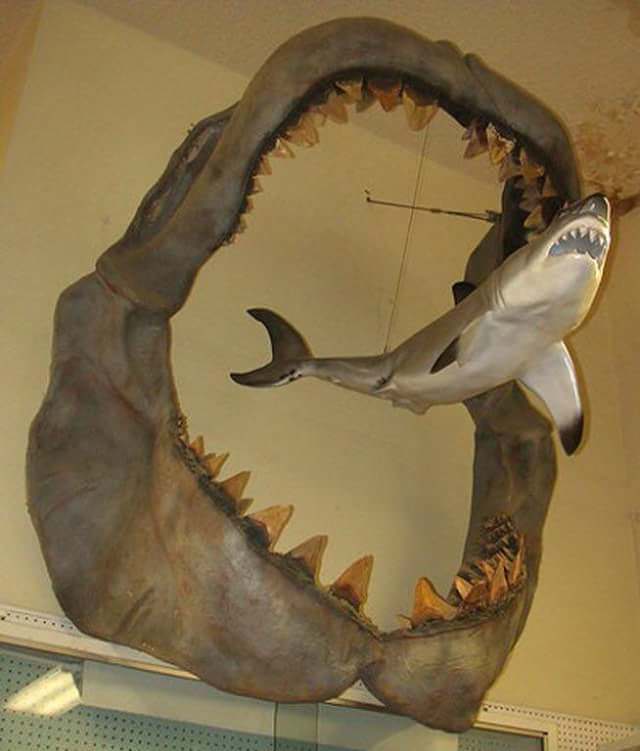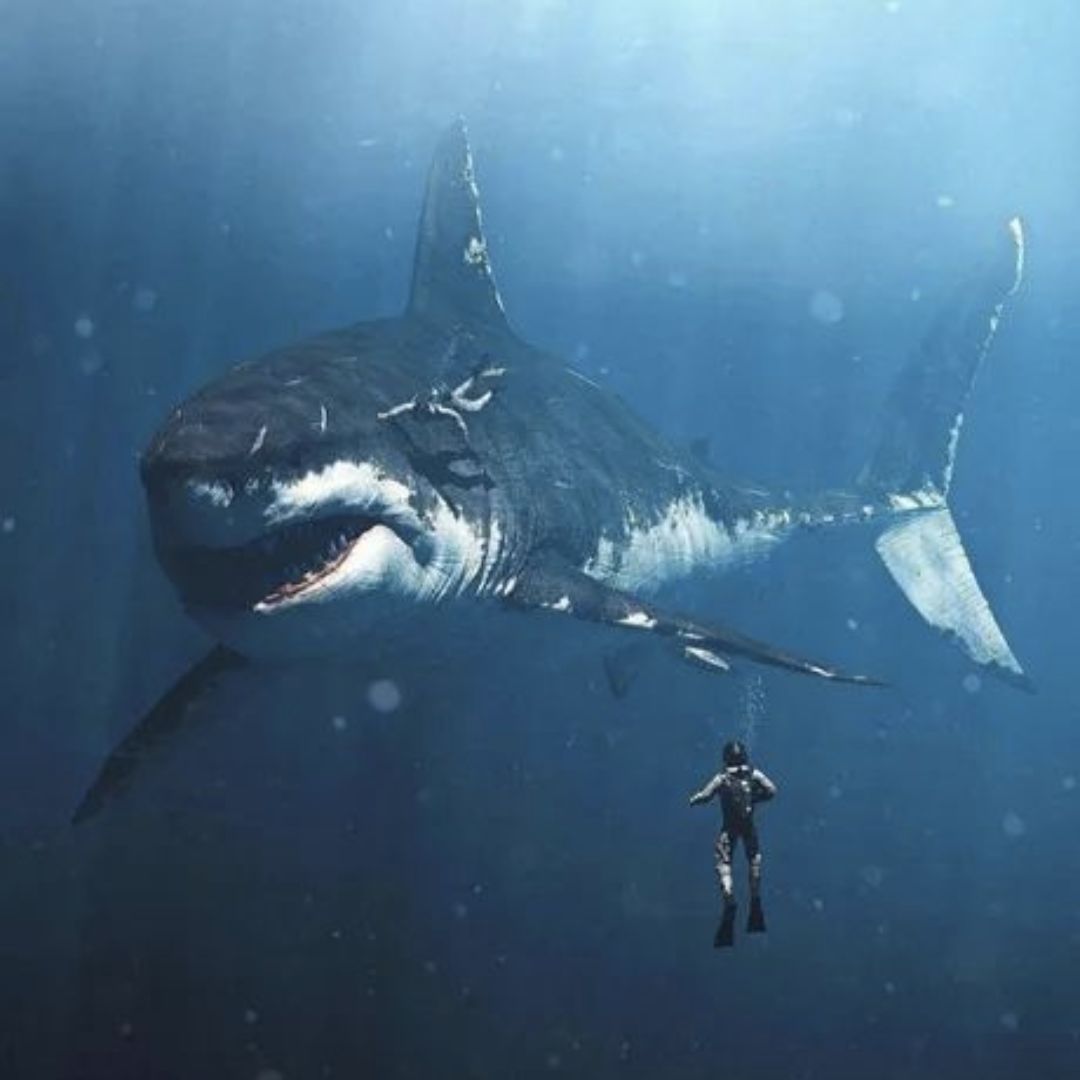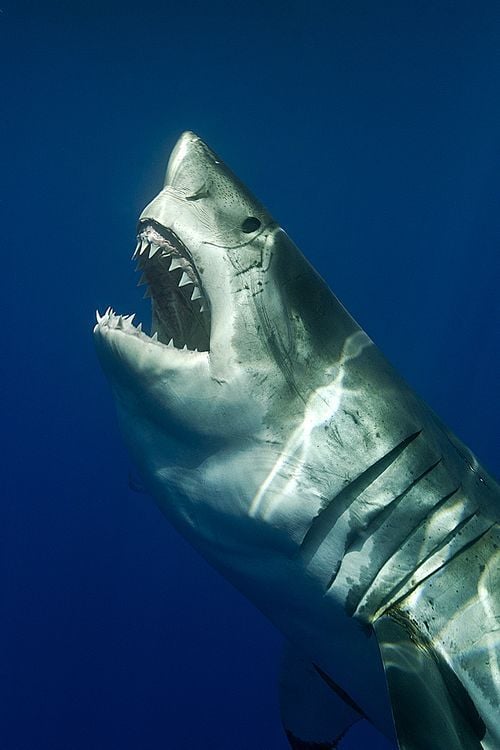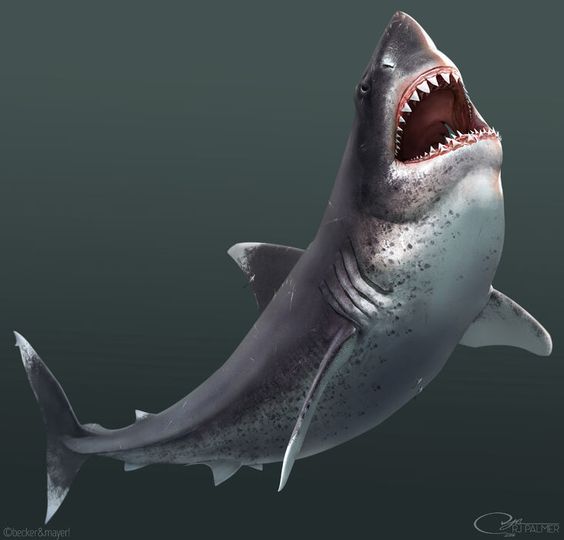The Megalodon: Did the Ocean’s Greatest Predator Actually Disappear?
The Megalodon is a massive prehistoric shark that ruled the sea millions of years ago. Researchers have been fascinated by this incredible sea creature for years because of its sheer size and the mystery that surrounds its disappearance. Some people are convinced this shark still roams around in unexplored areas of the ocean.
If you think great white sharks are scary, you have to see what a Megalodon looked like. Check out these unbelievable facts about the all powerful Megalodon and be grateful this shark isn’t still around next time you take a dip in the ocean.
Megalodon means “big tooth”
The Megalodon is the biggest shark ever recorded, so it had some pretty impressive chompers. In fact, the word Megalodon directly translates to “big tooth” which is a fitting name for an animal of this size.

Source: wullieblake/ imgur
The biggest Megalodon tooth ever recorded was 6.9 inches. For reference, that is an entire 3 times larger than the average great white shark’s tooth. They were triangular and serrated, making them the perfect tools to tear into their prey.
It was huge!
The Megalodon is one of the biggest sea creatures of all time. But how big was it? The smaller ones were about 60 feet which is literally the size of a bowling alley lane. Can you imagine? Some scientists speculate that they could have been more than 80 feet long.

Source: melancholyterminator/ imgur
These massive sharks could weigh as much as 143,000 pounds. For reference, Killer Whales only weigh about 7,000 pounds and those are absolutely huge beasts!
How do they compare to a great white shark?
Great white sharks are one of the most feared predators in the ocean today. So how would these guys measure up to the Megalodon? In short, they would be no match.

Source: bubblessayingdecent/ imgur
One scientist explained that a great white would measure to about the same size as a Megaladon’s reproductive parts. It would be only a fraction of the enormous beast! Great whites typically weigh between 4,000 and 5,000 pounds, so they would be completely dwarfed if they swam next to a Megalodon.
Where did the Megalodon go?
A question that still tortures scientists to this day is, “Where did it go?”. If the Meg was this enormous apex predator, why is it not around anymore? The shark went extinct about 2.6 million years ago.

Source: rhiever/ imgur
The mystery of the Megalodon is still unanswered to this day, although scientists and conspiracy theorists like to speculate as to what might have driven them to extinction. Some people even believe it could still exist to this day, hiding in the depths of the ocean.
The Megalodon’s mouth
The Megaladon’s mouth was obviously enormous. Its bite diameter was almost 10 feet tall. To put it into perspective, the Meg was large enough to swallow 2 adults in one single gulp. Yikes!

Source: whatnext/ imgur
Also, the Megalodon continuously produced new sets of teeth throughout its life. Researchers believe the average Meg would produce between 20,000 and 40,000 teeth in one lifetime.
The strength of the bite
Their bite was powerful as well as large. The strength behind the shark’s bite was enough to crush a car! Great Whites may be scary but they sure couldn’t fit your Toyota in their mouth.

Source: kirk quilaquil/ imgur
Researchers have found that the bite strength of the Megalodon was at least 3 times stronger than the bite strength of the T-Rex. We’d love to see a showdown between these enormous predators.
What did they eat?
Scientists and researchers have discovered that the Megalodon preyed all over the ocean because their teeth have been found on nearly every single continent. This comes as no surprise because an animal of that size would need to eat a ton to keep it sustained.

Source: baals imgur
This prehistoric beast preyed on large marine mammals such as whales. They ate baleen and humpbacks mainly but would also settle for dolphins, seals, and other sharks. Any large sea mammal that they could get their fins on was lunch.
They were hunters
Their obvious size and frightful teeth were not the only things that made them intimidating hunters. They were strategic in their hunting and were known to play with their food. Rude, we know.

Source: naturewasmetal/ reddit
They would hunt the whales and eat their flippers and tails first to make escape impossible. No animal really stood a chance against these massive creatures. They basically ruled the ocean!
No natural predators
Most scientists agree that the Megaladon did not have any natural predators. There was no recorded sea animal at the time that could hunt them or take over the animal’s strength. It seems like a pretty unfair advantage, but that’s the way of the world.

Source: bbc pinterest
Since the Meg was at the top of the food chain, the only time it was really vulnerable to attack was when it was a newborn. When a Megalodon is first born it is about 7 feet long, which means larger hammerheads or other sharks could potentially attack if they were brave enough.
Where did the Megalodon go?
Their extinction is very mysterious which leaves room for many theories. One of which is that the water temperature changes led to the end of the shark. When the Seaway that connected the Atlantic and Pacific oceans closed, ocean temperature dropped dramatically.

Source: pascalator pinterest
This was around the time that the Meg is predicted to have gone extinct, so some scientists believe the cooler temperatures were not habitable for the animal. Research has revealed that they preferred warm and shallow water.
Theory on where it went
Another theory as to the extinction of this shark is that the cooler water temperatures killed off much of the Megalodon’s food source, leading to their extinction.

Source: thoughtco.com/ pinterest
About ⅓ of all large marine mammals became extinct when the water temperatures dropped. This caused changes along the entire food chain. So, if the Meg didn’t have enough food to eat, then they would not have survived.
Could it still be alive?
Since there is so much mystery surrounding the disappearance of the Megalodon, people often wonder if it’s possible that the shark is still around today. However, almost all scientists agree that the Megalodon is certainly gone forever.

Source: lanhdanan imgur
Scientists agree that if the Meg were still alive today, we would know about it. Although we haven’t explored all of the vast ocean, we know enough that we would be aware of the giant sharks if they were still around.
The movie "The Meg" (2018)
A horror movie called The Meg released in 2018 and played on the conspiracy that the prehistoric shark is still alive. The plot follows ocean explorers who come across a living Megalodon. The animal has been surviving in the depths of the ocean, undetectable to humans.

Source: Joe Raedle/ Getty Images
As entertaining as the movie might be, scientists agree that it is not a possibility. If the Meg were still swimming around, we would come across animals with giant bite marks in them and their teeth would litter the ocean floors. While the movie isn’t accurate, it’s still a fun watch.
Would they eat humans?
Now let’s say the Meg does still haunt the ocean. Would they be interested in snacking on a human? Thankfully, the answer is “no”. Even if they were around today, we are so small in comparison that we wouldn’t even be worth the snack.

Source: earth science news int_l/ pinterest
It would be like if you hadn’t eaten all day and you had the choice between one almond or an entire pizza. Which are you going to go for? Lucky for us, we are just the almond.
They ate a ton (literally)
As you can imagine, the biggest fish that has ever lived ate a lot. And by “a lot” we aren’t talking about a few thousand calories. The Megalodon ate about 2,500 pounds of food per day! That’s a lot of food.

Source: imgur
Contrary to other sharks who can go weeks and potentially months without eating, the Megalodon needed to eat regularly since they were such large animals. They fed on whales, large fish, and most likely other sharks.
They are cold and warm-blooded
Most sharks are strictly cold-blooded since they spend their entire lives in the ocean. But the Megalodon, similar to great white sharks, is both cold and warm-blooded. This is because they actually generate heat while they swim.

Source: darknesfreak.deviantart.com/ pinterest
Since they were partially warm-blooded, they were able to swim and hunt in colder waters that other sharks would not have been able to hunt in. This added to their ability to be at the top of the food chain for millions of years.
Females were bigger than males
Female megalodons may have been as big as double the size of their male counterparts. Since Megalodons didn’t have bones, estimates of size are made based mainly on teeth fossils. According to fossils of the creatures the female sharks were both bigger in mass and length.

Source: lise-lotte pedersen/ pinterest
Researchers have drawn conclusions of the shark’s size from hundreds of fossil teeth, vertebral columns, and individual vertebrae. Even infants were enormous, starting at at least 6.6 feet in length. Scientists can only speculate the size in relation to the fossils they have found.
Physically they were similar to great whites
While megalodons were much much larger than great whites, they did share some physical similarities. They had similar tooth shapes, so scientists think that the two sharks were most likely close relatives.

Source: john hopperstad/ twitter
The head shapes were also similar in that they featured a bulky rounded snout and huge fins with a crescent-shaped tail. So think of the Megalodon as an incredibly large version of a great white shark.
They raised their young in nurseries
While scientists and researchers can only guess as to some of the habits of the Megalodon, they do assume that they raised their young in nurseries because they have found baby teeth in shallow warm-water areas.

Source: melancholyterminator/ imgur
Likely, this was to allow the younger sharks to hunt easier prey and allow the parents to protect their young. The only time that the Megalodon was really vulnerable in its lifetime was when they were babies and brave hammerheads would come for a snack.
Conspiracy theories about the Megalodon
While scientists can basically agree that the Meg is gone for good, people can’t help but speculate and think of their own conspiracy theories about the massive beast. One theory claims that the “black demon” still exists today.

Source: leviatha9/ pinterest
There is an old wives’ tale in Mexico that the shark attacks boats and kills fishermen. Blurry footage has captured a large presence underwater that some people claim as evidence of the shark’s existence.
Another theory
Other theorists claim that there isn’t enough evidence to support the fact that the shark has gone extinct. But scientists have debunked this time and time again by explaining that sharks are cartilaginous.

Source: Meredith/ pinterest
This means that they don’t have bones and so there aren’t bones to analyze. This explains the lack of “evidence” proving that the sharks are extinct. Scientists remind people that if they were still alive today, we would know about them. They’re too huge to hide and they lose their teeth so we would have found some by now.
Apparent “proof” of the shark’s existence
In 2016 a video surfaced that convinced conspiracy theorists that the Megalodon was still wandering in the deep unexplored waters of the ocean. The clip was apparently taken in the Mariana Trench and it looks like it shows a huge shark along the ocean floor.

Source: just amazing/ youtube
The video racked up hundreds of thousands of views and the internet went wild with speculation. But many scientists have debunked the video, explaining that it is too easy to fake or edit footage these days. But people love to believe the impossible!
Why is it impossible for the Meg to survive in the Mariana Trench
Theorists claim that since most of the ocean is still unexplored by humans, you could assume that there are things existing in those unexplored parts that we have no clue about. While this may be true, it would not be possible for a creature as large as the Meg to survive without our knowledge.

Source: just amazing/ youtube
The Mariana Trench is the deepest part of the ocean, but the shark could not survive there because the temperatures are far too cold. Thus, to the great disappointment of shark lovers everywhere, the Meg is decidedly extinct.
They hunted with stealth and skill
You don’t become the number 1 apex predator of the ocean without some skill. The sharks would attack their prey with precision and power. Like other shark species they attacked from below or behind.

Source: just amazing/ youtube
Then they would attack the flippers and fins of the prey, especially in the case of large animals. This would prevent them from swimming away and escaping. Their hundreds of teeth packed an impressive punch that few escaped from.
They did not coexist with dinosaurs
While this ancient shark does share some similarities with the dinosaurs, the two did not exist at the same time. Dinosaurs roamed the earth long before the Megalodon existed in the ocean.

Source: chrono66/ imgur
Dinosaurs lived between 245 and 66 million years ago whereas the Megalodon existed up until only 3 million years ago. The earliest Megalodon fossils are about 20 million years old, so dinosaurs and the Meg were pretty far apart in the timeline.
People once thought their teeth were tongues of dragons
In the middle ages, Europeans found Megalodon teeth had no idea what kind of creature could produce such large teeth. They didn’t even think that it was possible that these discoveries could be teeth due to their sheer size.

Source: yuckns/ imgur
They actually thought that they were “tongue stones” or fossilized tongues of dragons and snakes. Some cultures even wore the teeth as pendants and they were thought to have medicinal properties.
There are fossilized poop from Megalodons
There are not many body parts from Megalodons laying around these days so most of the research on them has been from their teeth. However, there have been some discoveries of their waste being fossilized.

Source: dinopedia.fandom.com/ pinterest
Fossilized feces is known as coprolites and the shape of these objects actually gives scientists a lot of insight into the shape and size of their intestines. One coprolite was actually 5.5 inches in length.
You can fossil-hunt for Megalodon teeth
There have been many Megalodon teeth found in the desert of Southern California in addition to many other animal fossils. You can go fossil-hunting and look for your very own ancient shark tooth.

Source: whatnext/ imgur
You might also discover fossils from whales, turtles, and sea cows on your search. There are Megalodon traces here because it used to be submerged underwater and it was a host to many Megaolodn sharks. It’s been called “Sharktooth Hill” in recent years.
Megalodon teeth were first discovered long ago
Although there has been a lot of renewed interest in discovering Megalodon teeth in recent years, finding these teeth is actually not new. The very first records of the Meg teeth can be traced all the way back to 70 AD.

Source: cousinlarry211/ imgur
Pliny the Elder thought that the triangular teeth had fallen from the sky during lunar eclipses. He wrote about them in his many famous writings. It wasn’t until 1611 that the naturalist Fabio Colonna recognized that the objects were shark teeth.
They roamed basically the entire world
Scientists are confident that the sharks were distributed basically around the entire world because they have found fossils on almost every continent other than Antarctica. This environment was too cold for sharks to thrive.

Source: orangesmile.com/ pinterest
They did thrive in warmer climates and coastal waters, but it seems they weren’t too picky about their territories. When you don’t have any natural predators, you basically get to pick and choose your favorite parts of the ocean!
They might have used surprise tactics on their prey
While we’ve already established that the large sharks would attack from below or behind their prey, they had a few other tricks up their sleeves when hunting. Since they were larger and often faster than anything they were hunting, they had huge advantages.

Source: media-cache-ak0/ pinterest
Scientists have discovered some broken spines on animals and have surmised that the Meg might have rammed into their prey at full speed to stun them. They would take this opportunity to capture and eat their prey. No one taught them not to play with their food!
Why were these sharks so big?
How does a shark grow to this size? And why have we not seen any mammal grow to be this large since then? The reason that the Meg was able to grow to such unbelievable sizes was as a result of an abundance of food.

Source: pinterest
At the end of the Mesozoic period, there was a surge in plant life which then caused an abundance of large marine mammals. These were the Megalodon’s favorite food so they evolved to become much larger. There hasn’t been an abundance of food like this since then.
They did have some competition
Megalodons did rule the ocean but they weren’t without some competition. A giant predatory whale known as Livyatan melvillei shared the same tastes and food preferences as the Megalodon so they weren’t the only hunters exploring the ocean.

Source: cnet3.cbsistatic.com/ pinterest
Similar to how the Megalodon ate other shark species, the giant whales ate other whales as well. We do not know if the two giants attacked one another but most likely they did fight over food.
Baleen whales grew in size once the Megalodon went extinct
To give you an idea of the significant impact that these predators had on ocean life, take a look at the size of the baleen whale. When the Meg went extinct, baleen whales like blue whales and humpbacks grew to be the large size they are today.

Source: cheersbigears/ imgur
This is because they were no longer competing with the Megalodon predator for food. There were still extremely high nutrient levels in the ocean so these whales grew to be what they are today: The largest animal on the planet today.
